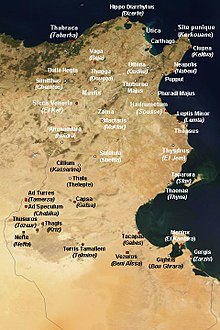
Turris Tamalleni was a town in North Africa,[1] dating from the Carthageinian, Roman, Byzantine and Vandal era.[2][3]

Turris Tamalleni was a town in North Africa,[1] dating from the Carthageinian, Roman, Byzantine and Vandal era.[2][3]
The town was west of Tacapes and South of Capsa.[4][5][6] It is located on the oasis of Mansura, 1.5 kilometers from Telmine and 7.5 kilometers from Kebili.
Turris Tamalleni town was founded before Carthage, when the Nybgenii Tribe established a fortified granary and a fortified residence for the tribal head.[7] It was renamed in the 1st century C. Civitas Nybgenorium, and remained the center of the Nybgenii Tribe[8] and the name Turres being probably the indigenous name.[9] It was originally a fort on the Roman Limes,[10] and linked by Roman Road under Domitian.[11] Later it became a municipium under Hadrian(about 105AD) taking the name Turris Tamalleni.[12] It is mentioned in the Antonine Itinerary on the road on the borders of Tripoli and Leptis Magna.[13] During the latter Roman era it was a Bishop's seat and a center of resistance of the Almoravids. The city was taken and destroyed by the Almohads in 1205AD.[14] An Arab town called Torrah or telmin was built from the rubble of the Roman town and is identified as runs at ruins of Oum-Es-Samâa. Today, nothing remains of the ancient city. All that remains of the ancient town is two large irrigation basins separated by a wall, which were restored in 1780 by the Bey of Tunis, they form a lake of one hectare.[15]
The Bishopric founded in the fourth century ceased to function with the arrival of the Arab forces, but remains a titular see of the Roman Catholic Church.[16] The current titular bishop is Linus Lee Seong-hyo, auxiliary bishop of Suwon.